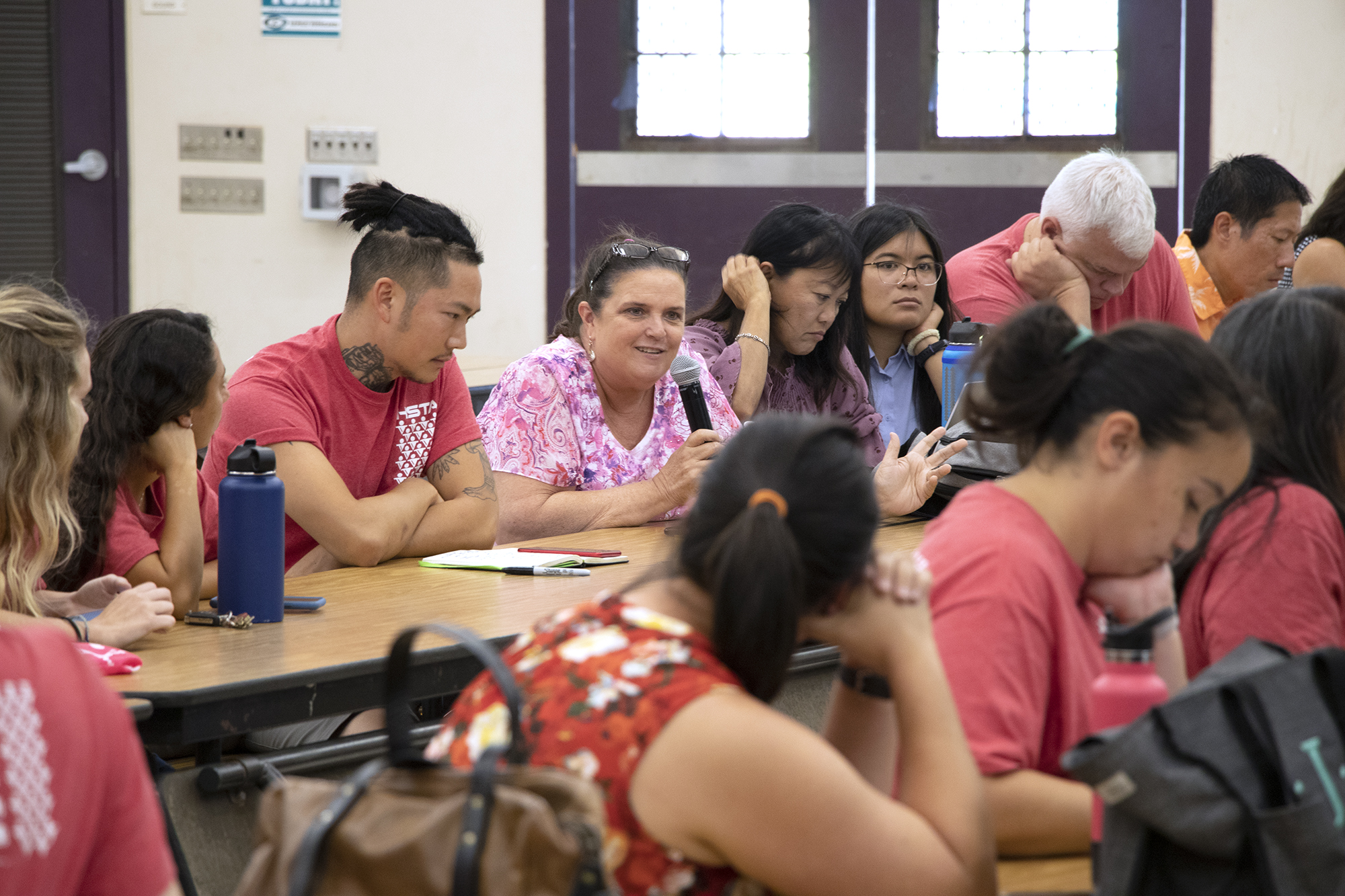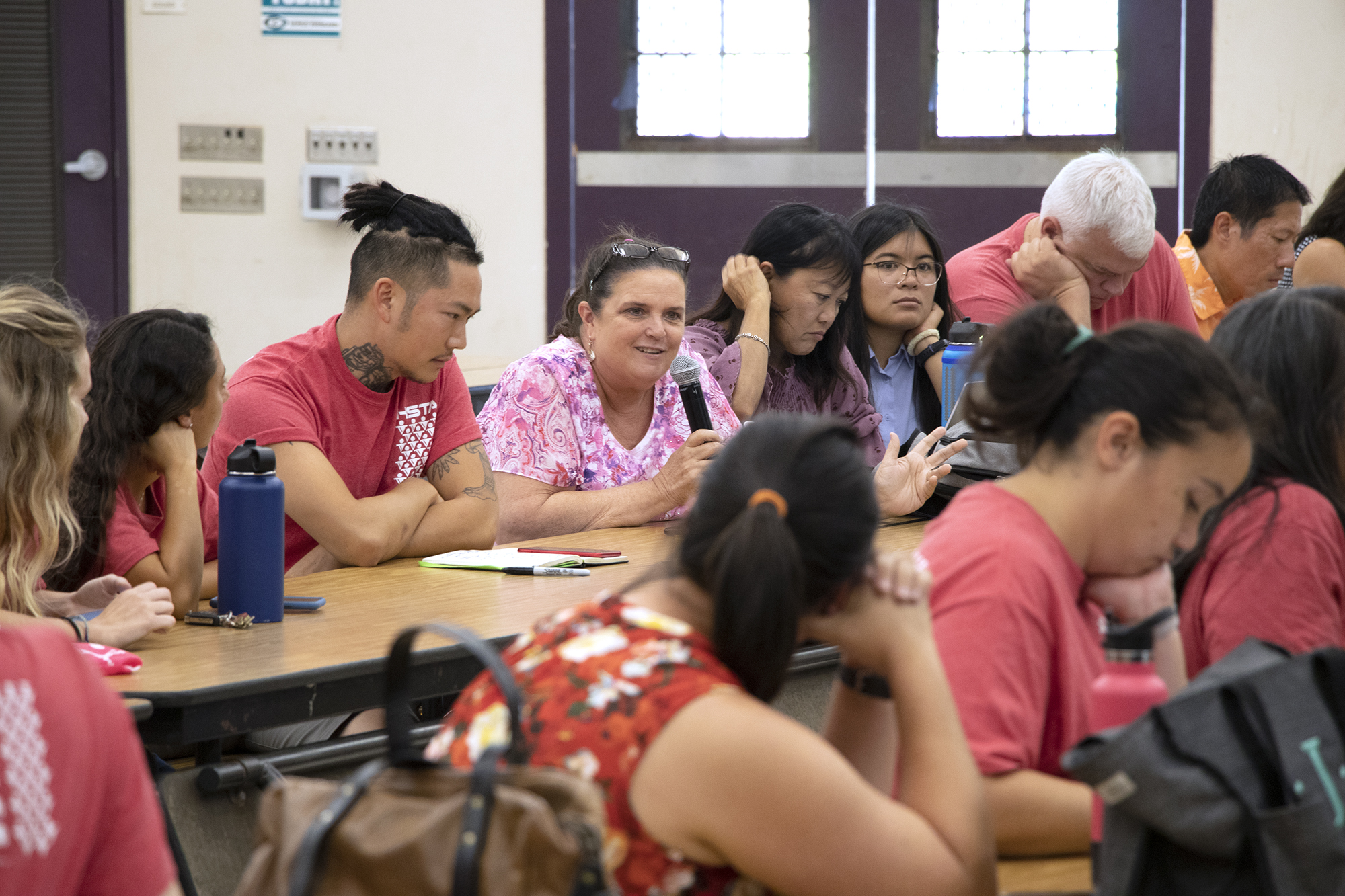
Julia Fernandez, who teaches preschoolers with special needs at Mokulele Elementary, was moved to tears Tuesday night as she talked about how difficult it is to be a low-paid public school teacher in Hawaii.
“I just feel like everything pushed on me is for the kids, but I don’t feel like anybody’s taking care of me. How can I take care of myself when I can’t support my family, and I can’t even think about the future? How am I supposed to teach my students,” asked Fernandez, as she wiped away tears from her eyes.
“You have to be able to take care of yourself so you can take care of the kids, and it’s hard to do that when I’m struggling inside all the time, and nobody’s taking care of me. It would mean the world to the students if they had a teacher who was mentally and physically present every single day,” said Fernandez, a graduate of the University of Hawaii at Manoa who’s from Aiea.
For those unable to attend a listening session, an online survey will be open from Sept. 23 through Oct. 6 to gather feedback. This survey will also be open to parents and community members.
Fernandez was one of more than 120 educators, students and community members who spoke at the state’s two listening sessions at Kapolei High School, held as part of a teacher salary study. The results of the study are scheduled to be released by the state later this year.
Second, third jobs make it hard for teachers to do their best for students
A sixth-grade teacher at Waianae Elementary, Chris Castillo says he works two side jobs at two gyms to help make ends meet because of Hawaii’s low teacher pay.
Educator salaries in the islands range from $49,000 for starting licensed teachers to about $89,000 a year for those with the most seniority. When you factor in Hawaii’s high cost of living, public school teachers here have the lowest average pay in the country.
Because of his two side jobs, Castillo said he gets home around midnight, “and when am I supposed to grade or do anything for my kids the next day?”
Castillo said it’s demeaning to have to spend so much of his own money on basic classroom supplies, food and even clothes for his students, many of whom live in poverty.
“If we want the materials in our room, if we want to do a project with the kids, it comes from us,” Castillo said. “Doctors don’t have to buy their own things in order to do surgery. It’s all provided for them. Nurses, in order to take care of their patients, dentists, police officers, firemen, all respected professionals have the things ready for them to serve the public. Why is it that we as teachers have to pay for our own goods in order to serve the public, to raise the future of America? That’s not fair for us. It’s not fair to the kids, because if I can’t afford to bring the materials, I can’t teach them.”
For those unable to attend a listening session, the state's online survey will be open from Sept. 23 through Oct. 6 to gather feedback. This survey will also be open to parents and community members.
Castillo is frustrated the Hawaii DOE spends so much money recruiting teachers from the continental United States, many of whom don’t stay in Hawaii for long, and some of whom don’t make it through the first semester.
“They’re willing to give so many bonuses for people outside of the state, why not pay us first and then look elsewhere,” Castillo said.
Krizia Bester teaches fifth grade at Pearl Harbor Kai Elementary and has a second job, which requires her to give up her weekends and nights. She uses the income from that second job to buy supplies for her students.
“We don’t get to travel as much, or go out on dates or hang out with our friends," because, she said, she makes so little money. “We end up having nothing left to save."
“With every raise, we were lucky to have gotten, medical goes up as well,” Bester added.
Campbell student can tell when long-term subs don’t know the material
Jahstyce Ahulau, a ninth-grade student at Campbell High School, spoke about the need for better pay to ensure that qualified teachers are in every public school classroom.
She said she has a long-term substitute in her Algebra II class this year, so “it’s been pretty difficult because we’re not really learning any new content. We’re just taking tests every other day but without being able to have the review or have our teacher working with us, it becomes more difficult, and I’m seeing that a lot of students are starting to struggle in class.”
Ahulau says students can tell when unqualified teachers don’t know their subject matter.
“It’s because they themselves will either admit it or you see that they’re struggling trying to give off the message, whether it’s they’re asking another teacher, they’re asking a student what should be taught, they’re going onto Google or whatever the case may be, you can tell because the teacher will often pause, or if you do ask for one-on-one help, your questions aren’t being answered and you’re not really getting all the information you need to be able to be successful in that class,” Ahulau added.
The teacher shortage crisis is an emergency, right?!
An emergency hire teacher at Campbell High, Wesley Adkins teaches geometry and Algebra II in an inclusion classroom.
The Kapolei cafeteria erupted in applause when Adkins said, “To call me an emergency hire and not treat it like an emergency is half-ass!"
Educators drowning in student loan debt because of low salaries
Michael Press, a seventh- and eighth-grade social studies teacher and department head at Ilima Intermediate school, said, “the teacher crisis is only a crisis because we let it get there,” by not paying teachers enough.
“I love this career. I really do, and I don’t want to give it up for anything, but I’ve got one more year of student loan deferment and I have $70,000 in student loan debt,” Press said.
He will soon decide whether to leave the teaching profession for better-paying work to pay off his college loans.
For those unable to attend a listening session, the state's online survey will be open from Sept. 23 through Oct. 6 to gather feedback. This survey will also be open to parents and community members.
Campbell High School teacher Christine Russo struggles to pay her monthly student loan payments and other expenses, so she works two to three extra jobs, including driving Uber on the weekends.
That means she’s burned out and doesn’t get to spend time with her daughter.
“I want to stay in this career field, but I used to waitress and I made more and was more financially stable as a waitress,” Russo said. “It comes down to the students. The students aren’t being taught by qualified teachers, because there’s such a mass exodus of teachers in Hawaii.”
Educators suggest great ideas to improve the profession
Suggestions made by educators at Kapolei Tuesday night included:
- Starting teacher salaries of at least $60,000,
- Paying average teacher salaries of $100,000,
- Reducing the number of credits needed for reclassification from 15 to 12,
- Raising hard-to-staff bonuses from $3,000 to at least $5,000 after taxes,
- Increasing mentor pay to encourage more veteran teachers to help new educators, and
- Offering a test-out option for professional development, because some teachers who taught PD have to retake basic courses they've led elsewhere.
The listening sessions and subsequent analysis are being conducted by Denver-based education consultants Augenblick, Palaich and Associates, hired by the DOE on a $130,000 contract.
Two listening sessions will be held at the dates and times below in each location on Maui and Hawaii Island. Following a short introduction, attendees were able to give feedback on how the state’s compensation system should be updated to best address the needs of students, educators, schools and districts. Some participants chose to introduce themselves by name and school where they teach, but others simply spoke without identifying themselves.
| Island | Date | Time | Location |
| Maui | Wednesday, Sept. 25 | 4–5:30 p.m. 6–7:30 p.m. |
Baldwin High School (Auditorium) |
| Hawaii Island | Thursday, Sept. 26 | 4–5:30 p.m. 6–7:30 p.m. |
Keaau High School (Cafeteria) |
The Hawaii State Teachers Association (HSTA) represents 13,700 public and charter school teachers across the state who teach 180,000 students at 293 schools.

